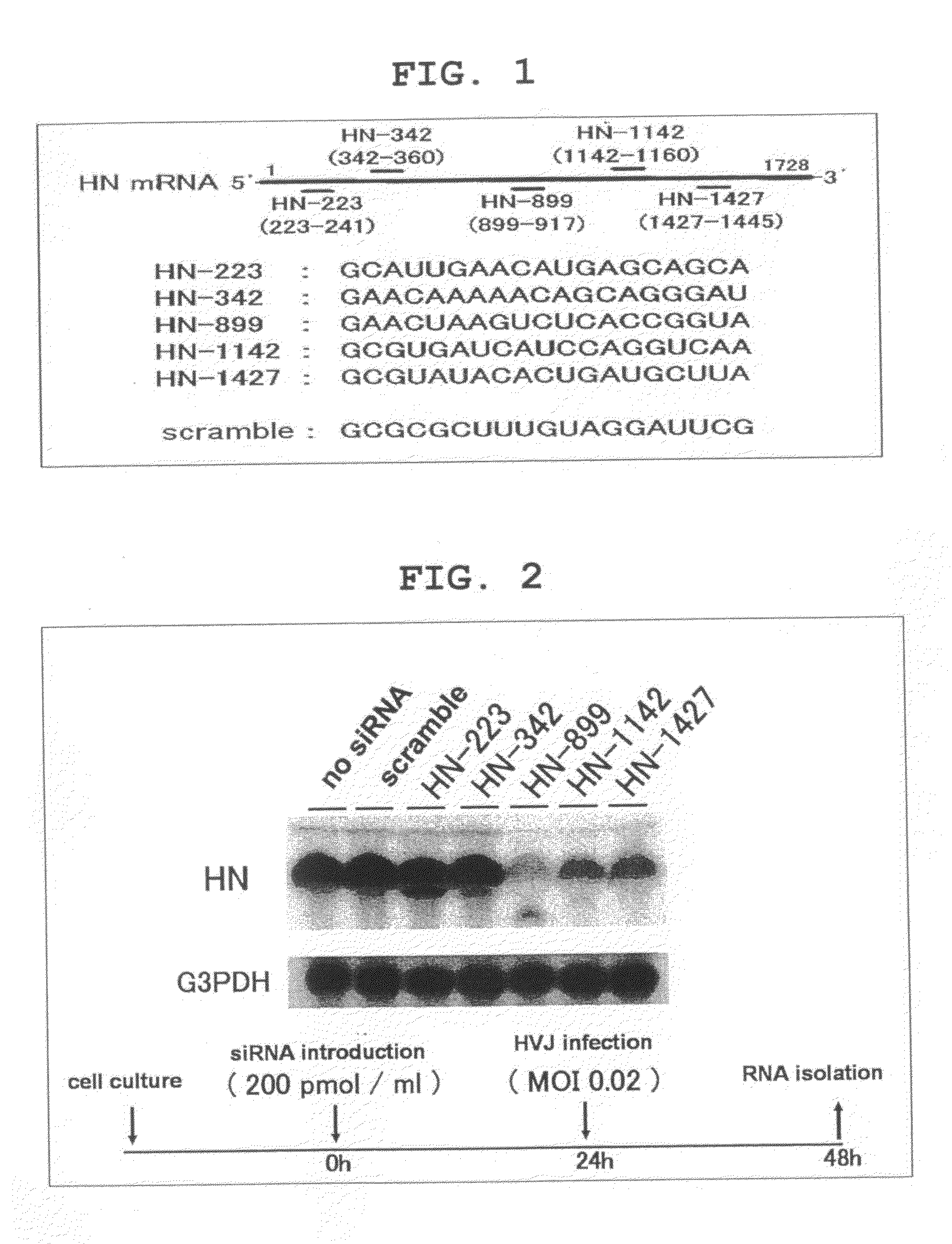Mutant Paramyxovirus and Method for Production Thereof
a technology of mutant paramyxovirus and mutant paramyxovirus, which is applied in the direction of viruses, peptides, dna/rna fragmentation, etc., can solve the problems of low cytotoxicity and immunogenicity of viral vectors, poor safety of non-viral methods, and inability to effectively induce gene introduction to cultured cells or living tissues. , to achieve the effect of reducing the amount of receptor-binding protein, reducing the adverse effect of receptor-bind
- Summary
- Abstract
- Description
- Claims
- Application Information
AI Technical Summary
Benefits of technology
Problems solved by technology
Method used
Image
Examples
example 1
(1) Preparation of siRNA Against HN mRNA
[0143]The five siRNAs for HN mRNA knock down shown in FIG. 1 were designed and synthesized using SMART siRNA Technology™ (Dharmacon Research). The five siRNAs (HN-223, HN-342, HN-899, HN-1142, HN-1427) target GCAUUGAACAUGAGCAGCA (223-241: SEQ ID NO:1), GAACAAAAACAGCAGGGAU (342-360: SEQ ID NO:2), GAACUAAGUCUCACCGGUA (899-917: SEQ ID NO:3), GCGUGAUCAUCCAGGUCAA (1142-1160: SEQ ID NO:4), and GCGUAUACACUGAUGCUUA (1427-1445: SEQ ID NO:5), respectively, on the HN mRNA. The scramble siRNA used as the control consists of a random sequence (GCGCGCUUUGUAGGAUUCG: SEQ ID NO:6).
(2) Detection of Effects of siRNAs
[0144]The synthesized siRNAs were introduced to LLCMK2 cells at various concentrations by utilizing Lipofectamin Reagent (Invitrogen™, California, USA) and Plus Reagent (Invitrogen™) in accordance with the respective protocols.
[0145]24 hours after introduction, cultured cells were washed with Dulbecco's Phosphate Buffered Saline (−) (PBS) (Nacalai Te...
example 2
(1) Preparation of Expression Vector for Chimera F Protein of HVJ-F and GFP or Dsg-3-scFv
[0158]Vectors for expressing the chimera EGFP-F proteins shown in FIG. 10 (i) to (iv) were prepared.
[0159]Using Mutagenesis (Promega), the pcDNA3.1-F plasmid was mutated to delete the intrinsically possessed BglII recognition site (279-284), and an AgeI recognition site (82-87) and a BglII recognition site (346-351) were newly prepared, to yield a new plasmid vector (pcDNA3.1-Fmut). This was cleaved with HindIII / XhoI, and the F fragment obtained was inserted into similarly cleaved pCY4B to yield pCY4B-Fmut. To insert EGFP into each of the BglII cleavage site ((i) in FIG. 10), AgeI-BglII site ((ii) in FIG. 1), AgeI-Eco47III site ((iii) in FIG. 10), and AgeI-EcoNI site ((iv) in FIG. 10) in pCY4B-Fmut, amplification from pEGFP-C1 (BD Biosciences Clontech) was performed by PCR to yield EGFP cDNA fragments.
[0160]The PCR primers used here are as follows:
(SEQ ID NO: 12)GFP-BglII-f:5′-CATGGTGAGCAAGGGCGA...
example 3
(1) Preparation of HVJ Presenting Transferrin on the Virus Particle Surface Thereof, and Exhibiting a Reduced Expression of HN Protein
[0194]As shown in FIG. 21, gene that encodes the F protein of HVJ was modified, and inserted into the expression plasmid pCY4B. To express a fusion protein of the transmembrane domain (TMD) of the F protein and human transferrin wherein human transferrin has been joined to the N-terminus side of the TMD, recombinant pCY4B was constructed. cDNA of human transferrin is shown by SEQ ID NO:22. In this operation, an insertion site was designed for the myc tag to attach to the N-terminus of the fusion protein to facilitate subsequent analysis. The sequence of the fusion protein inserted here is shown by SEQ ID NO:25.
[0195]In the amino acid sequence shown by SEQ ID NO:25, amino acid numbers 1 to 29 correspond to the signal sequence of HVJ-derived F protein, amino acid numbers 30 to 39 correspond to the myc tag, amino acid numbers 40 to 718 correspond to the ...
PUM
 Login to View More
Login to View More Abstract
Description
Claims
Application Information
 Login to View More
Login to View More - R&D
- Intellectual Property
- Life Sciences
- Materials
- Tech Scout
- Unparalleled Data Quality
- Higher Quality Content
- 60% Fewer Hallucinations
Browse by: Latest US Patents, China's latest patents, Technical Efficacy Thesaurus, Application Domain, Technology Topic, Popular Technical Reports.
© 2025 PatSnap. All rights reserved.Legal|Privacy policy|Modern Slavery Act Transparency Statement|Sitemap|About US| Contact US: help@patsnap.com



